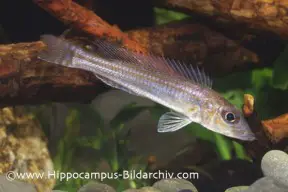Reganochromis calliurus
Classification
Cichlidae
Distribution
Endemic to Lake Tanganyika.
Habitat
This is a deep water (usually swimming at 60 metres depth or more) species found in coastal areas, usually over sandy or muddy substrates.
Maximum Standard Length
5.6″ (15cm).
Aquarium SizeTop ↑
48″ x 18″ x 15″ (120cm x 45cm x 37.5cm) – 200 litres
Maintenance
A fairly sparse set up is recommended, with a substrate of sand. Some rocky structures can be added around the back of the aquarium for breeding purposes and to give the fish some security.
Water Conditions
Temperature: 75-81°F (24-27°C)
pH: 8.0-9.2
Hardness: 8-25°H
Diet
It will accept most foods offered but live and frozen varieties should form the bulk of the diet. Vegetable matter does not feature in the natural diet but any meaty fare offered should not be animal in origin.
Behaviour and CompatibilityTop ↑
A peaceful fish that should not be kept with boisterous species such as mbuna, or other Tanganyikans with different dietary requirements. Good tankmates include Gnathochromis permaxillaris and Frontosa. It should be maintained in pairs and a large aquarium is required if more than one pair is to be kept as they become territorial once they have found a partner.
Sexual Dimorphism
No external sexual differences are apparent. The only sure method of sexing is by examining the vents of the fish, but this approach is only for the expert fishkeeper.
Reproduction
Possible but tricky. Bi-parental mouth-brooder. The breeding aquarium should be set up as suggested above. A pH of 8.0-9.0 and a temperature of 75-78°F are ideal. We recommend the purchase of a group of at least 6-8 young fish and allowing things to develop naturally. You will know when a pair has formed as they will often be seen together in a cave and will become territorial towards conspecifics.
Spawning occurs in the cave and both parents share brooding duties, often swapping the brood between themselves. They may also both hold fry at the same time if the brood is very large. They usually remain in the cave during this period.
The free swimming fry are released after around 3 weeks and will accept brine shrimp nauplii or microworm from this point.
NotesTop ↑
A rarely seen species in the hobby due to its deep water lifestyle and the associated difficulties with collecting it.


